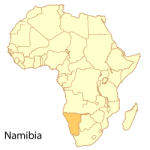Namibia
Highlights
- The Namib Desert
- Etosha National Park
- Neolithic Rock Art
- Adventure Activities
- Cultural activities

Namibia is a vast country; about four times the size of the United Kingdom. It is situated on the Atlantic Ocean on the southwest coast of Africa. Namibia borders Angola and Zambia in the north, South Africa in the south and southeast, Botswana in the east and Zimbabwe at the eastern extremity.
It is a former German colony that was placed under South African administration after World War 1. The landscape is mostly desert with a mainly rural population. Windhoek is the major city and location of the airport. The Skeleton Coast is dotted with tiny towns with many examples of fine European architecture and luxurious beach resorts. Namibia is sometimes referred to as “where Africa’s past and present meet in a vibrant mix of cultural diversity.”
The Namib Desert is a mosaic of sand and gravel plains, orange sand dunes and inselbergen or island mountains. The desert surface tells the tale of its many inhabitants. Tracks left by beetles, lizards, gerbils and moles mark the surface of one of the oldest deserts in the world. The Namib has one of the most varied spectrums of lichen species in the world. The rugged mountains and dunes can best be explored on foot. Although no rain falls here, thick sea mists, which can penetrate over 100 kilometers inland, help to sustain a remarkable variety of life. The Shafberg (sheep mountain) rises 250 meters above the desert and offers a far-reaching view of the dunes, in addition to having its own flora and fauna. Evenings offer a range of soft desert hues and at night the stars seem close enough to touch. The utter silence, peace and tranquility of the desert are an unforgettable experience.
Etosha National Park has over 300 types of birds and most of Africa’s big game. It is famous for its black rhino sightings. At the centre of the Park is the vast Etosha Pan, a shallow, salty depression, which was once a lake, but now only fills with shallow water in exceptionally wet years. Around the edge are many waterholes which attract wildlife.
While most of Europe and America was still under an ice cap, early man was creating rock art in Africa. Stories from 20 – 30 thousand years ago have been found throughout Namibia. Tales of man gaining control of even the strongest animals through the use of weapons are told with extraordinary paintings and carvings. Twyfelfontein contains many Bushman paintings and rock engravings carved into the sandstone. It is a very interesting area, made even more spectacular by the amazing rock formations.
The Kalahari Desert is part of the huge sand basin that reaches from the Orange River up to Angola, in the west to Namibia and in the east to Zimbabwe. The sand masses were created by the erosion of soft stone formations. The wind shaped the sand ridges, which are so typical of the landscape in the Kalahari. Unlike the dunes of the Namib Desert, those of the Kalahari are stable and not wandering. The dominant vegetation: grasses, thorny shrubs and Acacia trees, can survive long drought periods of more than ten months every year. The remarkable nests of the weaver birds in the camelthorn trees and in other acacias are a frequent sight in the Kalahari. Here you can see what remains of a once prolific people the San (Bushmen) still living a life-style close to that of Stone Age Man.
The Himba are one of the most traditional of African people with a semi-nomadic lifestyle, raising goats and cattle. They also maintain their distinctive dress of goat-leather, ochre painted skin and leather, iron and shell jewellery.
Adventure activities include rock climbing, hiking, dune-boarding, white water rafting, abseiling and quad biking. These busy days can be followed by a soak in one of the countries many natural hot springs.







